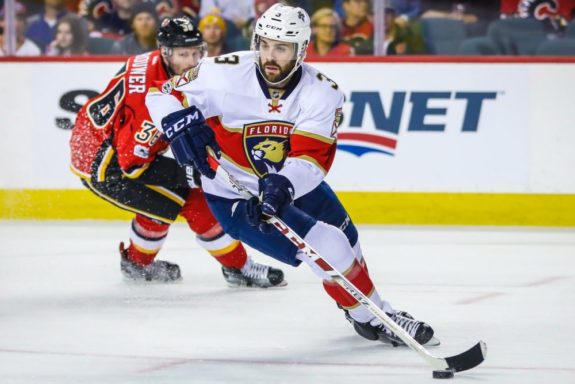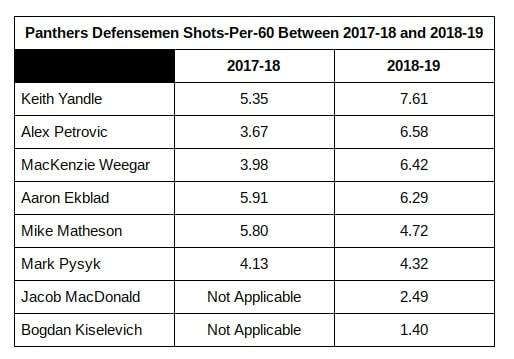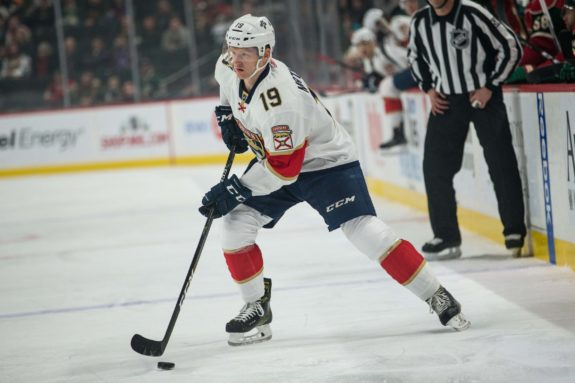![]()
The 2018-19 season hasn’t exactly started the way the Florida Panthers had envisioned. With a 3-5-3 record through 11 games and tied for last in the league ahead of the Nov. 6 games, things haven’t worked out in Sunrise. The reasons for their slow start are littered throughout: they rank 20th or worse in goals for, shot attempts, shooting percentage, save percentage, and PDO.
Individually, only two teams’ leader scorers have fewer points than Evgeni Dadonov’s 13 which lead the Panthers. It’s a similar situation in net as both Michael Hutchinson and James Reimer rank in the bottom-15 of the league by save percentage among goaltenders with at least two games played. But if there’s one area that stands out as the biggest culprit for their slow start, it’s the defense.
As a group, they have accumulated 22 points, which tied for fourth-fewest for team defenses ahead of the Nov. 6 games. And while eight different Panthers defensemen have points, only Keith Yandle is in double digits, with 12. Additionally, only three have netted goals and only Yandle has scored more than one.

Nowhere at the position has the lack of production stood out more than former Calder Trophy winner Aaron Ekblad and his zero goals and two points. Not much production considering his $7.5 million cap hit. But this season’s struggles for the team’s defense aren’t a new issue.
Compared to Last Season
The 2017-18 Panthers may have missed the postseason by just one point, but it took a Herculean effort at season’s end to finish that high in the standings. Again they finished in the bottom half of the league in multiple categories, including goals against, both special teams units, and shooting percentage. Also again, their blue line was a major reason for their struggles.
With 162 points as a position last season, the Panthers finished 44 points behind the league-leading Nashville Predators’ defense group. The Panthers’ 162 points were the equivalent of 1.98 points-per-game (P/G). This season, their 22 points in 11 games represent an average of 2.00 P/G and project to 164 points for the season.
By comparison, the team with the most defense points this season (as of Nov. 6), the Ottawa Senators, have 41 points in 14 games for an average of 2.92 P/G. The 2018-19 Panthers’ blue line may be ahead of last season’s group, but it’s still well behind where it needs to be for the team to be a playoff contender.
Are They Generating Enough Chances?
This season, Panthers defensemen have totaled 120 shots on net in their 11 games for an average of 10.9 shots-per-game (S/G). Compared to last season’s defense group which attempted 9.57 S/G, this year’s version is actually ahead of last year, so good news. It’s also a trend that continues as we look at individual defensemen.

As you can see, for the most part, Panthers defensemen have done a great job at generating shots on net, with all but Mike Matheson having increased his shot rate from last season. Four of their blueliners, Alex Petrovic, MacKenzie Weegar, Ekblad, and Yandle rank in the top-50 among NHL defensemen with at least 100 minutes.
The issue? Only Jacob MacDonald, Matheson, and Yandle have scored goals, leading to regression in shooting percentages for nearly all of them. This has resulted in only Yandle being in the league’s top-50 in shooting percentage for defensemen.
Which Defense Pairs Have Worked?
As of Nov. 6, the Panthers have four defense pairs who have shared the ice for at least 50 five-on-five minutes – Ekblad/Yandle, Kiselevich/Weegar, Petrovic/Yandle, and Ekblad/Matheson, from most to least used. For the most part, all four have performed well in terms of possession metrics. All have controlled at least 50 percent of shots and the Ekblad/Yandle and Kiselevich/Weegar pairs have controlled at least 50 percent of goals.
The struggles that have occurred when the pairs are deployed have been more the result of teammates’ play rather than their own. For instance, the Panthers have shot anywhere between 2.5 percent when Petrovic and Yandle have been deployed to 13.5 percent with Ekblad and Yandle on the ice. Not surprising considering the Panthers have the 27th-ranked shooting percentage this season.

It’s the same story in net with Panthers netminders having anywhere between an .844 save percentage (SV%) when Ekblad and Matheson are used and a .950 SV% with the Petrovic/Yandle pair deployed. The team’s inconsistent shooting and save percentages have led to the team having fluctuating PDO’s, an interesting stat that can prove valuable. Look at the Vegas Golden Knights from last season to this season as an example. For the Panthers, this up-and-down play has impacted the abilities of their defensemen to produce in a consistent manner.
Florida’s Pairs Relative to the League
Where the Panthers’ defensive struggles become evident is when the team’s pairs are compared to other NHL pairs. When looking at control of shots and goals, shooting and save percentages, and PDO, all at five-on-five, none of the pairs listed above rank higher than 11th in any category. That 11th ranking is by the Ekblad/Yandle duo, Florida’s most used and best pair, and they rank that highly in team shooting percentage when they are deployed. The pair also ranks 20th in shot control, but outside the top-20 in every other area.
The only other pair inside the top-20 in any category is Kiselevich and Weegar, which rank 13th in shot control, but outside the top-50 in all other categories. The same holds true for the Petrovic/Yandle and Ekblad/Matheson pairs, which rank outside the top-25 in all areas, including outside the top-100 in three categories.
Not Getting it Done on the Man Advantage
Panthers defensemen may be struggling at five-on-five, but nowhere are their struggles more pronounced than on the power play. The team may not have the strong puck-moving defensemen that the Predators or San Jose Sharks have, but Florida’s woes on the man advantage, especially from the blue line, are worse than could have been predicted.
Of course, as I mentioned at the top, the Panthers have a power play which, although it has come on as of late, especially in the NHL Global Series, is still only ranked 16th in the league at 20 percent having converted on 10 of 50 opportunities. Just seven Panthers have multiple points on the man advantage with Yandle, once again, being the only defenseman with more than one point as well as the only one with a power play goal.
In Luongo's return, Keith Yandle and the @FlaPanthers' power play came alive. #NHLTonight #NHLGlobalSeries pic.twitter.com/ZLNec030Qt
— NHL Network (@NHLNetwork) November 2, 2018
Of the 10 Panthers to have registered a point on the power play, Yandle, Ekblad, and Matheson are the only defensemen to do so and are also the only ones to average at least one minute per-game on the man advantage. Yandle has by far been the best Florida defenseman on the power play and leads the other two in all rate stats, including points and goals-per-60.
“He’s taking charge,” Panthers coach Bob Boughner said. “His assets are obviously the way he can pass the puck and see the ice offensively.” On Keith Yandle’s play (from ‘This Defenseman Has Been One of the Panthers’ Top Offensive Weapons’, Miami Herald – 11/7/18)
He also has an individual point percentage of 71.4, which measures the percentage of goals in which a player registers a point in a given situation when he is on the ice. In this specific circumstance, Yandle tallies a point on 71.4 percent of Panthers power play goals when he is on the ice.
But once again, none of the Panthers defensemen compare well to the rest of the league on the power play. Relative to defensemen with at least 10 minutes of ice time on the man advantage, Yandle and Ekblad are the only ones to rank in the top-10 in a category, both in shots-per-60, ranking ninth and 10th, respectively. Outside of that category, Yandle also ranks in the top-25 in goals-per-60 (13th), points-per-60 (25th), and shooting percentage (25th), but no other Panthers defenseman is ranked that highly.
Turning it Around
Currently the Panthers are in danger of falling far enough back in the playoff race that not even a late season push will save them. They have had to rely far too much on their borderline elite forward talent, specifically their top-six, while their defense, apart from Yandle, and goaltending have failed them. No one expected their blue line to post the production levels that the league’s elite defenses do, but more offense should be coming from several of their defensemen, specifically Ekblad.
Ekblad is now on a trajectory opposite of Yandle and one that should scare the Panthers, himself, and fans. Ekblad had a sizable bounceback last season after a down year in 2016-17, but even last season’s rate stats didn’t touch his rookie and sophomore seasons. Where he has continued to struggle, even in his bounceback season, is generating offense. Including this season, Ekblad’s ability to generate offense has now regressed for two straight seasons. These include the number of individual Corsi, Fenwick, and scoring chances he is generating per-60.

He may never again be the player he was in juniors or in his rookie season, but at 22, he can still develop into an elite, puck-moving defenseman. He needs to become that player, and soon, because if he doesn’t, the Panthers may not develop into a true Stanley Cup contender. For the Panthers to contend this season, a turnaround from Ekblad and his fellow defensemen not named Yandle will be key, because until then, their defense will remain one of the league’s worst.
*All stats from Hockey-Reference, Natural Stat Trick, and Corsica